NDVI stands for "Normalized Difference Vegetation Index". NRG stands for "Near-infrared / Red / Green". NDVI and NRG are both ways to visualize the amounts of infrared and other wavelengths of light reflected from vegetation. Because both these methods compare ratios of blue and red light absorbed versus green and IR light reflected, they can be used to evaluate the health of vegetation. It's a snapshot of how much photosynthesis is happening. This is helpful in assessing vegetative health or stress. (Read more here: https://www.agronomy.org/publications/jeq/articles/36/3/832) ## Do-It-Yourself These techniques for vegetation analysis were developed for satellite imagery, but at Public Lab, we've been working a lot on capturing infrared imagery using our DIY [near-infrared camera](/wiki/near-infrared-camera) setup, and combining it with visible bands to produce NDVI images such as the one above. ## What these images mean What exactly are these images we're trying to make? What do they tell us about vegetation, and why? These diagrams should help to understand what it is we're doing and why these are good ways to analyze plant life. ## The NDVI equation [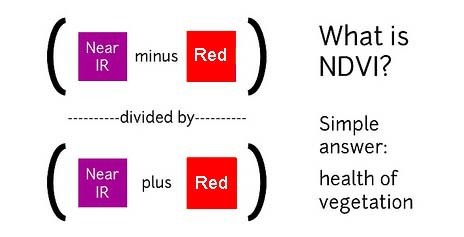](/i/44723) **NDVI = (Near Infrared - Red)/(Near Infrared + Red)** NDVI is a ratio which tries to emphasize photosynthesis while filtering out sun glare. The above equation is run for every pixel, using source data from an infrared photo and a visible light photo, like this pair: [](https://publiclab.org/system/images/photos/000/021/771/original/5390895115_c9d4d38fec_o.jpg) The result can be false-colored to make the high-photosynthesis areas more clear, and used to examine where plants are and how healthy they are. [](https://publiclab.org/system/images/photos/000/021/770/original/PetVISNDVIcomp.png) _Figure above: Normal color photo (right) and normalized difference vegetation index (NDVI) image (left). NDVI image was derived from two color channels in a single photo taken with a camera modified with a special infrared filter. Note that tree trunks, brown grass, and rocks have very low NDVI values because they are not photosynthetic. Healthy plants typically have NDVI values between 0.1 and 0.9. -- @cfastie_ ### Activities Here are a range of activities you can do to produce and interpret your own NDVI imagery, whether downloaded from a satellite imagery provider or [collected yourself using a DIY technique](/wiki/multispectral-imaging) [activities:ndvi] ****   Most DIY converted cameras today (those from Public Lab) use RGN instead of NRG, so the blue channel represents infrared instead of the red channel. That looks like this: [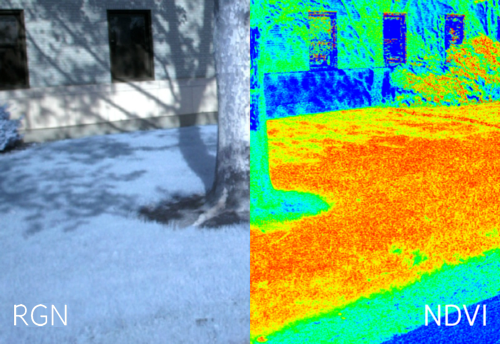](/i/45468?s=o) **** ## NRG imagery Some people are also interested in producing NRG imagery (like the below image), where `Near-Infrared, Red, and Green` are used to compose a picture instead of the usual `Red, Green, and Blue`. [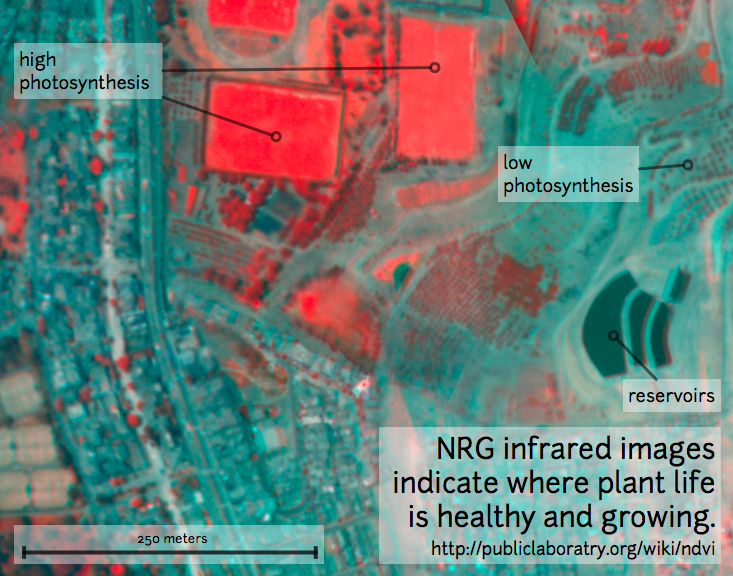](/i/25064) This diagram explains the swapping, which allows us to 'see' infrared as if it were a normal color: [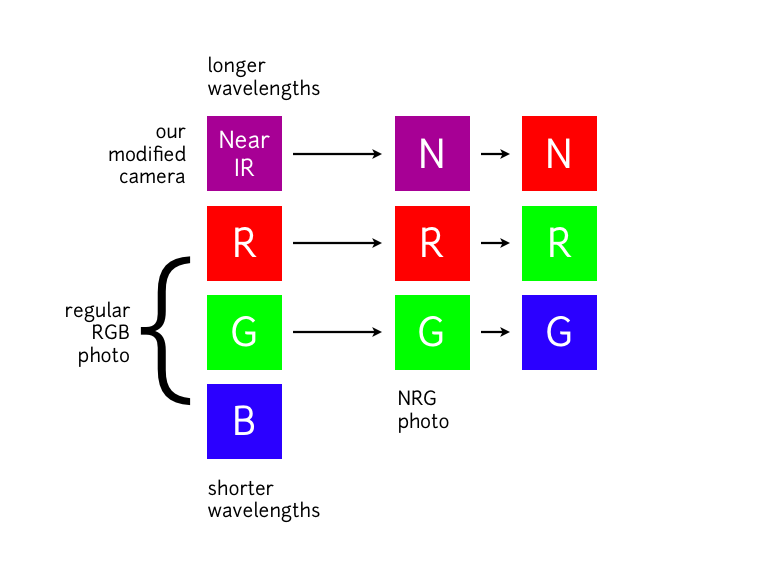](/i/25063) **In NRG images, the deeper and clearer the red color, the denser and healthier the vegetation (more or less).** ### Questions [questions:ndvi] ### Other examples of DIY NDVI imaging From around the internet: Begin watching at 2 minutes to see the resulting imagery: *This topic is part of the [Grassroots Mapping Curriculum](/wiki/mapping-curriculum) series.* **** [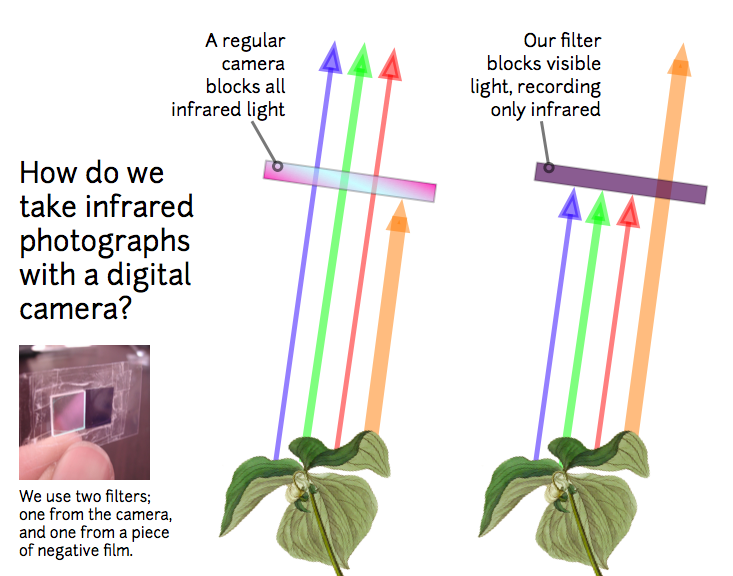](/i/25066) [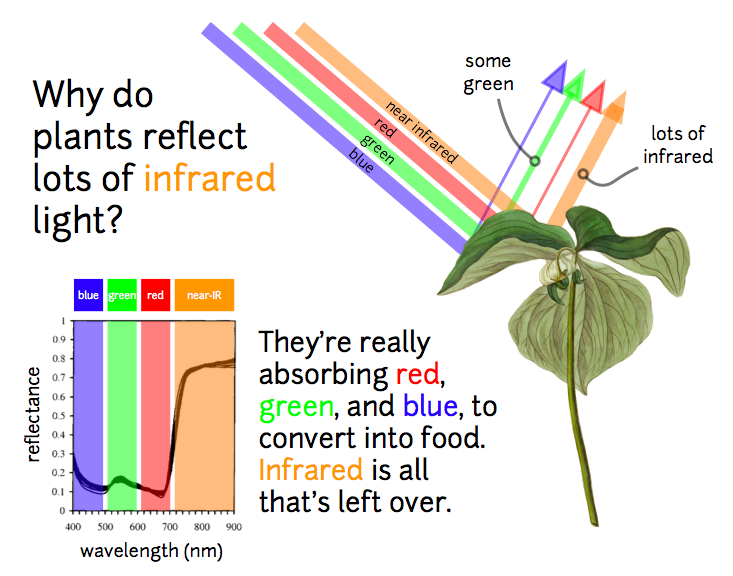](/i/25065) ...
| Author | Comment | Last activity | Moderation | ||
|---|---|---|---|---|---|
| nickyshen0306 | "Thanks for giving me so many solutions!! I will try it. " | Read more » | over 5 years ago | |||
| lfent | "@cfastie I found that I needed the heavy cyan filtration (at the expense of all the exposure variables you mention) to achieve an image approximati..." | Read more » | over 5 years ago | |||
| cfastie | "@lfent, Is there any difference between using two filters and using one filter if both photos are exposed so the photos have the same general brigh..." | Read more » | over 5 years ago | |||
| lfent | "Yes, a cyan filter will block the red light from the red-NIR pixels, may I suggest the Rosco 4390 CalColor 90 Cyan gel filter. I found that I need ..." | Read more » | over 5 years ago | |||
| nedhorning | "Here are a couple ways to do this. One is to use two cameras mounted as close as possible to one another with the shutter release synchronized to b..." | Read more » | over 5 years ago | |||
| smsficks | "Hi this is Manan Thanks For sharing This informative Article For Authentic Resources. I really Like Your Website. Thanks a Lot. medical laboratorie..." | Read more » | over 5 years ago | |||
| cesarharada | "Very interesting indeed! " | Read more » | over 5 years ago | |||
| icarito | "Hi this is very interersting! @warren " | Read more » | over 5 years ago | |||
| nickyshen0306 | "Thank you for your helping hands!! " | Read more » | over 5 years ago | |||
| cfastie | "The inexpensive red and blue filters used in DIY single camera NDVI systems typically block most green light. So the camera's green channel capture..." | Read more » | over 5 years ago | |||
| nstarli | "Hi Peter, you explained that you used the GUI to manually find your proper balance, however how did you actually quantify what made a good photo? " | Read more » | over 5 years ago | |||
| evan_lesmez | "Lol wish I had saved the blue filter it shipped with " | Read more » | over 5 years ago | |||
| evan_lesmez | "This is awesome I am working on implementing this into analyzing my hydroponic garden. Just got my piNoIr camera running & am looking through y..." | Read more » | over 5 years ago | |||
| shivparkash05 | "awesome & click here more " | Read more » | over 5 years ago | |||
| fernando3216 | "Hello, I would like to know what are the values of dry and live vegetation, let's say? " | Read more » | over 5 years ago | |||
| DaleHCook | "As a follow up, I do not do IR photography so I have not looked elsewhere on Public Lab, but good results could likely be achieved with a DSLR that..." | Read more » | over 5 years ago | |||
| kauemv2 | " Hello, I have a photo take with this kind of sensor: https://www.dropbox.com/s/7dddzda6at9d8a7/2019_0502_154807_246.JPG?dl=0 Hope that these one..." | Read more » | over 5 years ago | |||
| warren | " Hi! Just noting that this software stack I mentioned above is configured to run headlessly and to send video over WiFi, including NDVI processing:..." | Read more » | over 5 years ago | |||
| warren | " Hi! Noting this project which may be of interest: https://gitlab.com/bath_open_instrumentation_group/picamera_cra_compensation And pinging @magg..." | Read more » | over 5 years ago | |||
| parker_rose | "@silentsairam I believe it has something to do with the size. I managed to bring one down and delete it and the other one I brought down in size b..." | Read more » | over 5 years ago | |||
| parker_rose | " My apologies for the delay. That's interesting. I need to look further into this. When it's a regular picture I have no problem deleting them. ..." | Read more » | over 5 years ago | |||
| petter_mansson1 | " Hello, my input might guide you in the right direction. Different environments require different settings so it might be hard to generalize. I did..." | Read more » | over 5 years ago | |||
| kauemv2 | "But, only one more question before I make that post: what if i just apply the proper weights (in post-process, at the time of ndvi calculation) to ..." | Read more » | over 5 years ago | |||
| silentsairam | " Thanks @parker_rose This is the link https://mapknitter.org/maps/airpollution Test by deleting the two distorted images in the map. Not sure why i..." | Read more » | over 5 years ago |